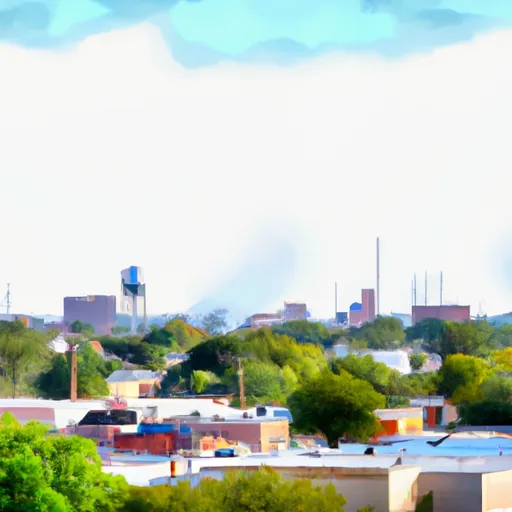-
 Snoflo Premium
Snoflo Premium
Get unlimited access to all our content
With no Ad interruptions! - Start Your Free Trial Login with existing account
Silver
Eden Index
Climate
7.9
•
Recreation
2.2
•
Community
•
Safeguard
3.9/10

Silver, Texas is a small town nestled in the heart of the Lone Star State. The climate in Silver is characterized as subtropical, with hot summers and mild winters. Summers are typically long, hot, and humid, with temperatures frequently reaching the high 90s Fahrenheit. Winters are relatively mild, with temperatures rarely dropping below freezing.
Hydrology in Silver is primarily influenced by the nearby Brazos River and its tributaries. These water sources provide essential irrigation for the region's agricultural activities, supporting crops such as cotton and sorghum. The river also offers opportunities for fishing and boating enthusiasts.
Outdoor recreation opportunities in Silver are abundant. The town is surrounded by picturesque landscapes, including rolling hills, lush forests, and open prairies. Nature lovers can explore the numerous hiking and biking trails, go birdwatching, or enjoy a peaceful picnic in one of the local parks. Hunting is also popular in the area, with a variety of game species available.
In conclusion, Silver, Texas offers a subtropical climate with hot summers and mild winters. It benefits from the hydrological influence of the Brazos River, providing irrigation for agriculture and recreational opportunities like fishing and boating. The town's natural beauty and diverse landscapes provide ample outdoor recreation opportunities such as hiking, biking, birdwatching, and hunting.
What is the Eden Index?
The Snoflo Eden Index serves as a comprehensive rating system for regions, evaluating their desirability through a holistic assessment of climate health, outdoor recreation opportunities, and natural disaster risk, acknowledging the profound impact of these factors on livability and well-being.
Climate Health Indicator (CHI): 7.9
Silver receives approximately
547mm of rain per year,
with humidity levels near 89%
and air temperatures averaging around
18°C.
Silver has a plant hardyness factor of
8, meaning
plants and agriculture in this region tend to thrive here all year round.
By considering the ideal temperature range, reliable water supplies, clean air, and stable seasonal rain or snowpacks, the Climate Health Indicator (CHI) underscores the significance of a healthy climate as the foundation for quality living.
A healthy climate is paramount for ensuring a high quality of life and livability in a region, fostering both physical well-being and environmental harmony. This can be characterized by ideal temperatures, reliable access to water supplies, clean air, and consistent seasonal rain or snowpacks.
Weather Forecast
Streamflow Conditions
Upper Colorado
Area Rivers
Upper Colorado
Snowpack Depths
Upper Colorado
Reservoir Storage Capacity
Upper Colorado
Groundwater Levels
Recreational Opportunity Index (ROI): 2.2
The Recreational Opportunity Index (ROI) recognizes the value of outdoor recreational options, such as parks, hiking trails, camping sites, and fishing spots, while acknowledging that climate plays a pivotal role in ensuring the comfort and consistency of these experiences.
Access to outdoor recreational opportunities, encompassing activities such as parks, hiking, camping, and fishing, is crucial for overall well-being, and the climate plays a pivotal role in enabling and enhancing these experiences, ensuring that individuals can engage in nature-based activities comfortably and consistently.
Camping Areas
| Campground | Campsites | Reservations | Toilets | Showers | Elevation |
|---|---|---|---|---|---|
| Wildcat Park - Spence Reservoir | 14 | 1,932 ft | |||
| Equalization Channel - Twin Buttes Reservoir | None | 1,956 ft | |||
| San Angelo State Park | 200 | 1,944 ft | |||
| Robert Lee City Park | 8 | 1,842 ft | |||
| Goodfellow AFB Military | None | 1,879 ft | |||
| Middle Concho Park | None | 1,880 ft | |||
| Paint Creek Park - Spence Reservoir | 10 | 1,925 ft | |||
| Water Valley County Park | 18 | 2,071 ft | |||
| Spring Creek Marina & RV Park - San Angelo | 83 | 1,873 ft | |||
| Twin Buttes Park | None | 1,946 ft |
Nearby Ski Areas
Catastrophe Safeguard Index (CSI):
The Catastrophe Safeguard Index (CSI) recognizes that natural disaster risk, encompassing floods, fires, hurricanes, and tornadoes, can drastically affect safety and the overall appeal of an area.
The level of natural disaster risk in a region significantly affects safety and the overall livability, with climate change amplifying these risks by potentially increasing the frequency and intensity of events like floods, fires, hurricanes, and tornadoes, thereby posing substantial challenges to community resilience and well-being.
Community Resilience Indicator (CRI):
The Community Resilience Indicator (CRI) recognizes that education, healthcare, and socioeconomics are crucial to the well-being of a region. The CRI acknowledges the profound impact of these elements on residents' overall quality of life. By evaluating educational resources, healthcare accessibility, and economic inclusivity, the index captures the essential aspects that contribute to a thriving community, fostering resident satisfaction, equity, and social cohesion.

